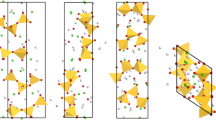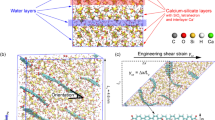Abstract
A comprehensive insight into the interactions between cementitious matrices and graphene oxide (GO) remains critical to the understanding of fundamental factors, such as reinforcing mechanisms, governing the engineering performance of cement composites. Herein, for the first time, this study investigated the snubbing effect on the interaction of GO in cement mortar. Molecular dynamic (MD) simulations were performed to pull out GO sheets from the mortar matrix from different angles. Simulation results showed that the increase in pull-out angle led to up to a fourfold increase in the bridging stress of GO, which confirmed the critical role that the snubbing effect played on the reinforcing mechanism of GO. To further understand the snubbing effects, interactions between GO and mortar matrix were analysed from both physical and chemical perspectives, showing the increase in bridging stress caused by pull-out angles is mainly attributed to the enhanced mechanical interlocking and the facilitated formation of interfacial bonds. Based on these findings, an analytical model was developed to quantify the key parameters of the snubbing effects, including snubbing coefficient, adhesion band, friction and strain-hardening coefficient, which guides design inputs of GO-reinforced cementitious composites.
Graphical abstract









Similar content being viewed by others
References
Cao C et al (2015) High strength measurement of monolayer graphene oxide. Carbon 81:497–504
Suk JW et al (2010) Mechanical properties of monolayer graphene oxide. ACS Nano 4(11):6557–6564
Montes-Navajas P et al (2013) Surface area measurement of graphene oxide in aqueous solutions. Langmuir 29(44):13443–13448
Gao W (2015) The chemistry of graphene oxide. Graphene oxide. Springer, pp 61–95
Xia ZM, Wang CG, Tan HF (2018) Strain-dependent elastic properties of graphene oxide and its composite. Comput Mater Sci 150:252–258
Chen Y et al (2019) Multifunctional graphene-oxide-reinforced dissolvable polymeric microneedles for transdermal drug delivery. ACS Appl Mater Interfaces 12(1):352–360
Xiang Z et al (2017) Reduced graphene oxide-reinforced polymeric films with excellent mechanical robustness and rapid and highly efficient healing properties. ACS Nano 11(7):7134–7141
Xiang Z et al (2018) Healability demonstrates enhanced shape-recovery of graphene-oxide-reinforced shape-memory polymeric films. ACS Appl Mater Interfaces 10(3):2897–2906
Xia X et al (2021) Uncovering the glass-transition temperature and temperature-dependent storage modulus of graphene-polymer nanocomposites through irreversible thermodynamic processes. Int J Eng Sci 158:103411
Hu Z et al (2016) Laser sintered single layer graphene oxide reinforced titanium matrix nanocomposites. Compos B Eng 93:352–359
Lin D, Liu CR, Cheng GJ (2014) Single-layer graphene oxide reinforced metal matrix composites by laser sintering: Microstructure and mechanical property enhancement. Acta Mater 80:183–193
Zhao YC et al (2019) Graphene oxide reinforced iron matrix composite with enhanced biodegradation rate prepared by selective laser melting. Adv Eng Mater 21(8):1900314
Chuah S et al (2014) Nano reinforced cement and concrete composites and new perspective from graphene oxide. Constr Build Mater 73:113–124
Shamsaei E et al (2018) Graphene-based nanosheets for stronger and more durable concrete: a review. Constr Build Mater 183:642–660
Pan Z et al (2015) Mechanical properties and microstructure of a graphene oxide–cement composite. Cement Concr Compos 58:140–147
Mohammed A et al (2015) Incorporating graphene oxide in cement composites: a study of transport properties. Constr Build Mater 84:341–347
Kai MF, Zhang LW, Liew KM (2019) Graphene and graphene oxide in calcium silicate hydrates: Chemical reactions, mechanical behavior and interfacial sliding. Carbon 146:181–193
Hu Y et al (2018) Transformation of pore structure in consolidated silty clay: new insights from quantitative pore profile analysis. Constr Build Mater 186:615–625
Fan D, Lue L, Yang S (2017) Molecular dynamics study of interfacial stress transfer in graphene-oxide cementitious composites. Comput Mater Sci 139:56–64
Fan D, Yang S, Saafi M (2021) Molecular dynamics simulation of mechanical properties of intercalated GO/CSH nanocomposites. Computat Mater Sci 186:110012
Wang P et al (2020) Molecular dynamics simulation of the interfacial bonding properties between graphene oxide and calcium silicate hydrate. Const Build Mater 260:119927
Li VC, Wang Y, and Backer S (1991) A micromechanical model of tension-softening and bridging toughening of short random fiber reinforced brittle matrix composites
Liu Y, Wang M, Wang W (2018) Electric induced curing of graphene/cement-based composites for structural strength formation in deep-freeze low temperature. Mater Des 160:783–793
Tragazikis IΚ et al (2019) Acoustic emission investigation of the effect of graphene on the fracture behavior of cement mortars. Eng Fract Mech 210:444–451
Fe S, Zhou B, Lung C (1992) On the pull-out of fibers with fractal-tree structure and the interference of strength and fracture toughness of composites. Smart Mater Struct 1(2):180
Fu S-Y, Lauke B (1997) The fibre pull-out energy of misaligned short fibre composites. J Mater Sci 32(8):1985–1993
Zhao L et al (2018) Hydration kinetics, pore structure, 3D network calcium silicate hydrate, and mechanical behavior of graphene oxide reinforced cement composites. Constr Build Mater 190:150–163
Chen SJ et al (2017) Reinforcing mechanism of graphene at atomic level: Friction, crack surface adhesion and 2D geometry. Carbon 114:557–565
Lin ZT. Kanda, and Li VC (1999) On interface property characterization and performance of fiber reinforced cementitious composites
Duque-Redondo E et al (2021) Microscopic mechanism of radionuclide Cs retention in Al containing C-S-H nanopores. Computat Mater Sci 190:110312
Senftle TP et al (2016) The ReaxFF reactive force-field: development, applications and future directions. npj Comput Mater 2(1):1–14
Sadat MR, Muralidharan K, Zhang L (2018) Reactive molecular dynamics simulation of the mechanical behavior of sodium aluminosilicate geopolymer and calcium silicate hydrate composites. Comput Mater Sci 150:500–509
Psofogiannakis GM et al (2015) ReaxFF reactive molecular dynamics simulation of the hydration of Cu-SSZ-13 zeolite and the formation of Cu dimers. J Phys Chem C 119(12):6678–6686
Van Duin AC et al (2003) ReaxFFSiO reactive force field for silicon and silicon oxide systems. J Phys Chem A 107(19):3803–3811
Manzano H et al (2012) Confined water dissociation in microporous defective silicates: mechanism, dipole distribution, and impact on substrate properties. J Am Chem Soc 134(4):2208–2215
Chenoweth K, Van Duin AC, Goddard WA (2008) ReaxFF reactive force field for molecular dynamics simulations of hydrocarbon oxidation. J Phys Chem A 112(5):1040–1053
Bonaccorsi E, Merlino S, Kampf AR (2005) The crystal structure of tobermorite 14 Å (plombierite), a C-S–H phase. J Am Ceram Soc 88(3):505–512
Hou D, Zeyu L, Li X, Ma H, Li Z (2017) Reactive molecular dynamics and experimental study of graphene-cement composites: structure, dynamics and reinforcement mechanisms. Carbon 115:188–208. https://doi.org/10.1016/j.carbon.2017.01.013
Gao W (2015) The chemistry of graphene oxide. In: Gao W (ed) graphene oxide. Springer International Publishing, Cham, pp 61–95. https://doi.org/10.1007/978-3-319-15500-5_3
Jin Y, Duan F, Mu X (2016) Functionalization enhancement on interfacial shear strength between graphene and polyethylene. Appl Surf Sci 387:1100–1109
Lu L, Zhang Y, Yin B (2020) Structure evolution of the interface between graphene oxide-reinforced calcium silicate hydrate gel particles exposed to high temperature. Comput Mater Sci 173:109440
Hou D et al (2018) Reactive force-field molecular dynamics study on graphene oxide reinforced cement composite: functional group de-protonation, interfacial bonding and strengthening mechanism. Phys Chem Chem Phys 20(13):8773–8789
Zhang Y et al (2018) Molecular dynamics study on the weakening effect of moisture content on graphene oxide reinforced cement composite. Chem Phys Lett 708:177–182
Daly M et al (2016) Interfacial shear strength of multilayer graphene oxide films. ACS Nano 10(2):1939–1947
Acknowledgements
The authors are grateful for the financial support of the Australian Research Council (IH150100006) in conducting this study.
Author information
Authors and Affiliations
Corresponding author
Ethics declarations
Conflict of interest
The authors declare that they have no conflict of interest.
Additional information
Handling Editor: M. Grant Norton.
Publisher's Note
Springer Nature remains neutral with regard to jurisdictional claims in published maps and institutional affiliations.
Supplementary Information
Below is the link to the electronic supplementary material.
Rights and permissions
About this article
Cite this article
Yao, X., Shamsaei, E., Sagoe-Crentsil, K. et al. The interaction of graphene oxide with cement mortar: implications on reinforcing mechanisms. J Mater Sci 57, 3405–3415 (2022). https://doi.org/10.1007/s10853-021-06808-y
Received:
Accepted:
Published:
Issue Date:
DOI: https://doi.org/10.1007/s10853-021-06808-y




